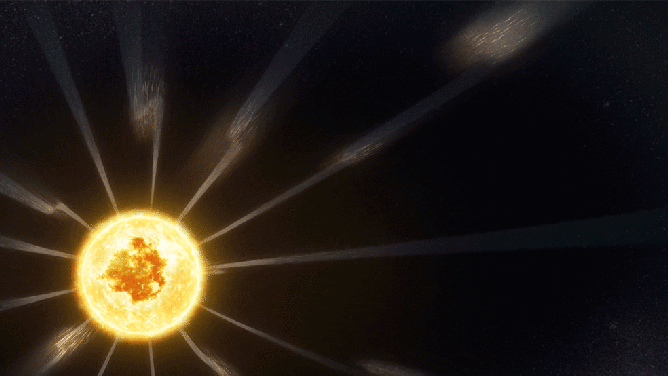NASA spacecraft 'touches the sun' revealing secrets of our closest star
Parker Solar Probe entered the sun's atmosphere in April.

NASA Solar Parker Probe was designed to help solve our star's mysteries. This animated image shows solar wind. Credit: NASA/Johns Hopkins APL/Goddard Space Flight Center Conceptual Image Lab/Adriana Manrique Gutierrez
NASA says for the first time a spacecraft has "touched the sun" when the Parker Solar Probe blasted through the sun's upper atmosphere, known as the corona.
Parker Solar Probe launched from Cape Canaveral, Florida, in 2018 and took three years to reach the sun's atmosphere. This is the closest a spacecraft has even been to our solar system's star.
NASA associate administrator for the Science Mission Directorate, Dr. Thomas Zurbuchen, said this is "a truly remarkable feat."
"Not only does this milestone provide us with deeper insights into our Sun's evolution and its impacts on our solar system, but everything we learn about our own star also teaches us more about stars in the rest of the universe," Zurbuchen said in a statement.
The milestone moment was captured with data from Parker Solar Probe's wide-field imager instrument showing what it looked like outside the spacecraft as it flew through streamers in the corona.
Scientists revealed new findings based on the mission on Tuesday at the American Geophysical Union Fall Meeting. According to a recent study, Solar Parker Probe has determined where the sun's atmosphere begins.
Unlike terrestrial planets, like Earth, the sun does not have a solid surface but a superheated atmosphere bound by gravity and magnetic forces, according to NASA. As heat rises, moving away from the sun, it escapes sending solar wind out into the solar system, including to Earth.
The point where this material begins escaping the sun is known as the Alfvén critical surface, which is the boundary that marks the beginning of the sun's atmosphere. Scientists were unsure where this boundary began until now. Previous estimates put the border between 4.3 to 8.6 million miles from the sun's surface; however, on April 28, the probe encountered the conditions around 8.1 million miles from the surface, telling the spacecraft's team it had crossed the Alfvén critical surface, entering the sun's atmosphere.
"We were fully expecting that, sooner or later, we would encounter the corona for at least a short duration of time, but it is very exciting that we’ve already reached it," said Justin Kasper, the lead author on a new paper using Parker Solar Probe's findings.
Parker Solar Probe has crossed the boundary several times, and NASA scientists say this shows that the boundary is not smooth but has peaks and valleys like a ripple around the sun.
Parker's mission is just beginning, and the spacecraft will continue to circle closer to the sun, eventually reaching less than 4 million miles from the surface.